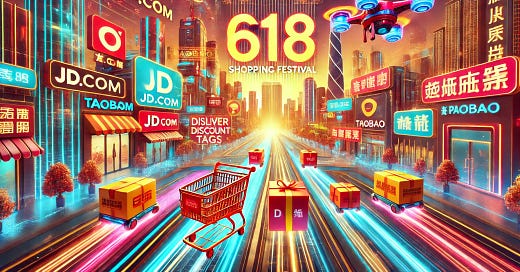China's 618 Shopping Festival
A Strategic Guide for Global Business Leaders on China's major shopping campaigns
As one of the world’s largest consumer markets, China’s e-commerce landscape is defined by high-stakes shopping festivals that drive billions in revenue and shape retail trends.
Among these, the 618 Shopping Festival stands out as a crucial event for businesses aiming to capture Chinese consumer demand. This article provides a deep dive into the festival’s significance and strategic insights for global executives.
The Evolution of 618
The 618 Shopping Festival, held annually on June 18, was launched by JD.com in 2004 to celebrate its anniversary. Over two decades, it has evolved into a nationwide e-commerce extravaganza, second only to Alibaba’s Singles’ Day (November 11) in scale and influence.
Today, it spans 2–4 weeks, typically running from June 1 to June 18, with platforms like JD.com, Taobao, and Pinduoduo offering aggressive discounts and promotional campaigns.
Why 618 Matters for Businesses
A Barometer of Consumer Confidence
The festival serves as a key indicator of China’s retail sector health. Analysts closely watch its performance to gauge post-pandemic recovery trends and shifts in consumer spending habits. In 2024, platforms leveraged deep discounts and innovative marketing to boost consumer confidence.Strategic Sales Opportunity
618 provides businesses with a mid-year revenue surge and an opportunity to acquire new customers. JD.com, for instance, has transformed it into a consumer engagement powerhouse, drawing both domestic and international brands.Consumer Behavior Insights
The festival highlights evolving shopping preferences, such as the growing demand for cost-effective products, livestream shopping, and sustainable goods. These insights help brands refine product strategies year-round.
Winning Strategies During 618
Flash Sales & Deep Discounts: Limited-time offers create urgency, with discounts often exceeding 50%.
Omnichannel Retailing: E-commerce players integrate platforms like WeChat and Douyin to optimize user engagement.
AI-Driven Personalization: Algorithms tailor recommendations to consumers, boosting conversion rates.
Sustainability Initiatives: In 2024, platforms prioritized eco-friendly packaging and carbon-neutral logistics.
Post-Pandemic Shifts & 2024 Trends
Consumption Recovery Focus: Retailers introduced subsidies on electronics, home appliances, and travel packages to stimulate spending.
Growth in Tier-2 & Tier-3 Cities: E-commerce penetration is expanding beyond China’s top urban centers.
Global Brand Participation: International giants like Apple, L’Oréal, and Nike are increasingly leveraging 618 to expand their China footprint.
Key Takeaways for Global Executives
Market Entry & Expansion
618 provides an opportunity to test new products and enter the Chinese market with reduced risk. Partnering with local e-commerce platforms facilitates seamless logistics and marketing execution.Consumer Data & Insights
The festival serves as a valuable data source for analyzing price sensitivity, category demand, and emerging trends such as health tech and smart home devices.Brand Visibility & Competitive Edge
High traffic during 618 offers unmatched brand exposure, even for smaller businesses leveraging targeted promotions. Tracking competitor strategies, such as JD.com’s focus on premium imports or Pinduoduo’s price-driven tactics, enables businesses to refine their approach.
Conclusion
The 618 Shopping Festival is more than a sales event—it’s a strategic inflection point for businesses seeking to thrive in China’s $2 trillion e-commerce market.
For global executives, mastering its dynamics is key to navigating China’s retail ecosystem, consumer behavior shifts, and regulatory trends. As 618 continues to evolve, staying attuned to its rhythms will remain crucial for long-term success in the world’s most competitive digital marketplace.


